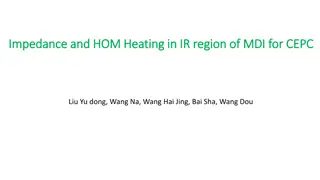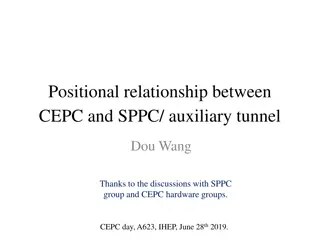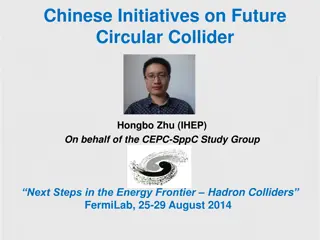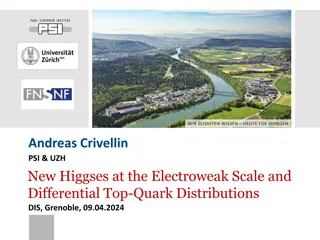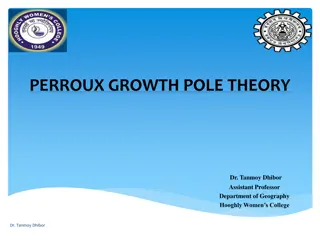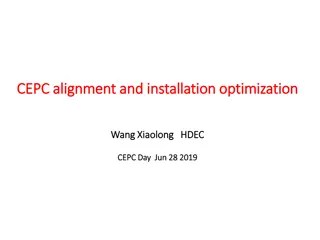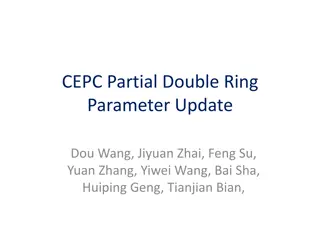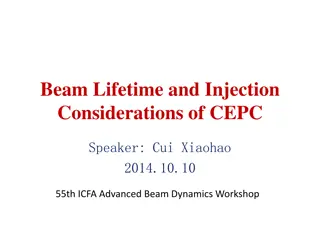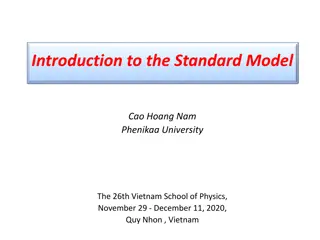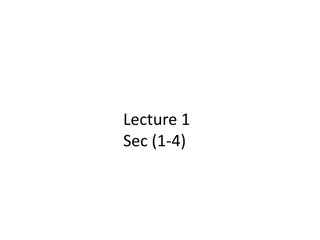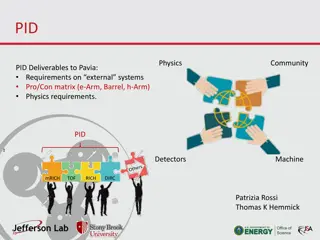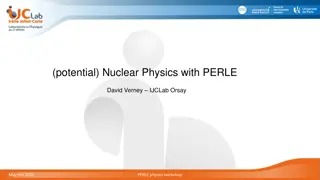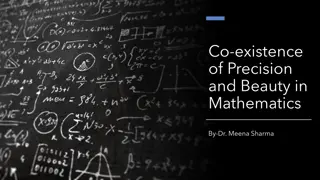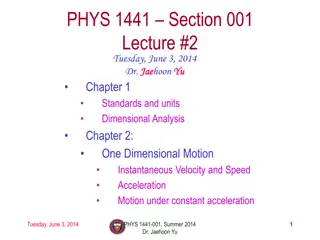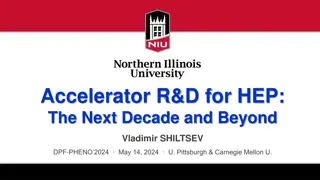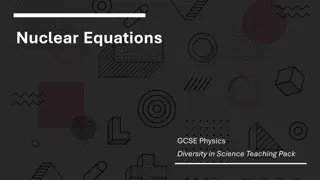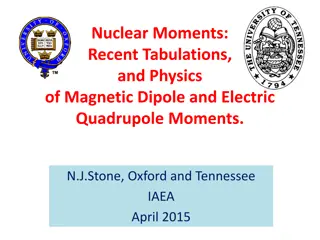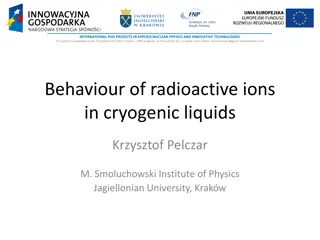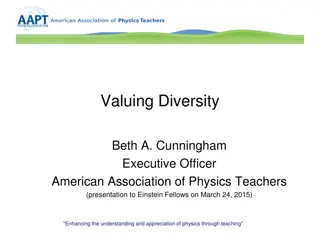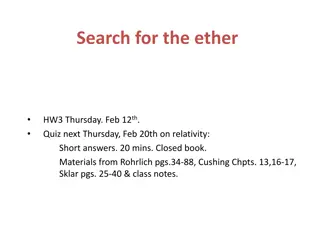Advancements in Electroweak Precision Physics at Z Pole in CEPC
CEPC is making remarkable progress in electroweak precision physics at the Z pole, aiming for significant improvements in luminosity and precision measurements. Research on W/Z physics, branching ratios, gluon splitting, systematics reduction, and detector enhancements are key focus areas. CEPC expects to achieve exceptional results in W mass measurement and reduce errors to unprecedented levels. Cutting-edge technology and simulation techniques are driving advancements in fundamental particle physics studies.
Uploaded on Sep 15, 2024 | 0 Views
Download Presentation

Please find below an Image/Link to download the presentation.
The content on the website is provided AS IS for your information and personal use only. It may not be sold, licensed, or shared on other websites without obtaining consent from the author. Download presentation by click this link. If you encounter any issues during the download, it is possible that the publisher has removed the file from their server.
E N D
Presentation Transcript
Physics at Z pole Zhijun Liang IHEP, CAS 1
Introduction CEPC have good potential in electroweak precision physics at Z pole. Latest design in CEPC Z pole accelerator L=1.6 X 1035 cm-2s-1(one order of magnitude larger than pre-CDR) Aim to have 1011Z boson for electroweak precision physics The accelerator design for WW threshold scan runs are also updated Total luminosity 3.2 ab-1 Aim to have 1 MeV level precision for W mass measurement More details in Hengne and Peixun s talk 2
Status of W/Z physics study in CEPC The prospect of W/Z physics study in CEPC are under study New full simulation with latest detector geometry and magnetic field (3T) 3
Branching ratio ( Rb) LEP measurement 0.21594 0.00066 (~0.3%) Stat unc and Systematics Unc. Have similar contribution CEPC Expected Stat Unc. Is neglectable Expected Syst error (0.02%) Expect to use 80% working points 15% higher efficiency than SLD 20-30% higher in purity than SLD Uncertainty LEP CEPC Thing to improve hemisphere tag correlations for b events 0.2% 0.02% B tagging performance, pixel gluon splitting ~0.15% 0.01% Better granularity in Calo 4
Rb : hemisphere tag correlations Study hemisphere b tag correlations systematics with full simulation Two ways to reduce correlations factor -> reducing systematics Using higher efficiency b tagging working points Using tighter cuts to choose Z->bb events Correlations factors c_b need to be reduced below 0.01% (systematics 0.02%) By Bo Li (Yantai University ) Jet2_cos? Jet1_cos? 5
Branching ratio ( Rb): gluon splitting To reduce the R_b systematics Another task is to measure gluon splitting plan to setup dedicated analysis for gluon splitting measurement Phys Lett B 405 (1997) 202 6
Branching ratio ( R) LEP result: 0.2% total error (Stat : 0.15%, Syst : 0.1%) CEPC : 0.01% total error expected Higher granularity and better resolution in EM calorimeter is the key Momentum scale resolution in CEPC Systematics source LEP CEPC Radiative events (Z-> ) 0.05% 0.01% Muon Momentum scale 0.009% <0.005% 7
Weak mixing angle LEP/SLD: 0.23153 0.00016 ~0.07% precision. (Stat error is limiting factor. ) CEPC Aim for 0.002% precision Input from Backward-forward asymmetry measurement of Z->bb and Z-> Z->ee, Z->?? have not been studied yet. LEP 8
Backward-forward asymmetry LEP measurement : 0.1000+-0.0017 (Z peak) Method 1: Soft lepton from b/c decay (~2%) Select one lepton from b/c decay, and one b jets Select lepton charge (Q_lepton) and jet charge (Q_jet) Method 2: jet charge method using Inclusive b jet (~1.2%) Select two b jets use event Thrust to define the forward and background Use jet charge difference (Q_F - Q_B) Q_lepton - Q_jet in method 1 Arxiv:Hep-ex/0107033 Q_F - Q_B in method 2 Arxiv: Hep-ex/0403041 9
Backward-forward asymmetry LEP measurement : 0.1000+-0.0017 (Z peak) Method 1: Soft lepton from b/c decay (~2%) Method 2: jet charge method using Inclusive b jet (~1.2%) Method 3: D meson method (>8%, method) CEPC Focus more on method 2 (inclusive b jet measurement) Expected Systematics (0.15%) : Uncertainty LEP CEPC Things to improve hemisphere tag correlations for b events 1.2% 0.1% Higher b tagging efficiency QCD and thrust axis correction 0.7% 0.1% 10
Backward-forward asymmetry in Z-> LEP measurement : 1.69% +-0.13%(PDG fit) CEPC aim to improve it by a factor of 20~30 . muon angular resolution and acceptance the precision of beam energy measurement Full simulation studies to understand muon angular resolution Muon angular resolution can reach 1e-4to 1e-5level By Mengran Li (IHEP) 12
Weak mixing angle (2) Comparison with Fcc-ee on weaking mixing angle measurement Expect 1~2 order magnitude better than LEP results Improvement compared to LEP results CEPC FCC-ee (from Paolo s talk) AFB (Z->ee) NA 50 AFB (Z-> ) 20-30 30 AFB (Z->??) NA 15 AFB (Z->bb) 10 5 Weak mixing angle 30 100 13
Summary CEPC electroweak physics community is working on in Conceptual Design Report. updated in CEPC accelerator design on Z pole and WW threshold runs one order of magnitude larger than pre-CDR Prospect of CEPC W/Z physics improved benefitted from higher design luminosity More details about W physics in Hengne and Peixun s talk Welcome to join this effort Lots of work needed to understand the systematics 14


